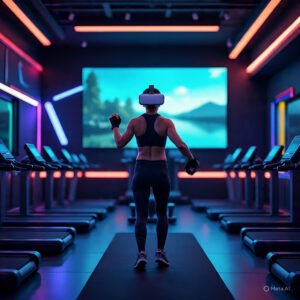Virtual Reality Fitness

Educational overview — structured for policy compliance and readability.
Introduction
VR fitness blends exercise with immersive technologies to make training more engaging and data-driven. Below we outline how multi-sensory systems, game mechanics, and global studio models are shaping the next wave of digital fitness.
The Era of Sensory Exercise
Complete immersion with haptics and thermal cues
Modern setups go far beyond visuals. Headsets and accessories deliver haptic feedback—simulating wind, impact, or load—and thermal modulation that mimics cool alpine air or warm desert heat. These cues heighten enjoyment and may improve movement quality and effort regulation when programmed responsibly.
Exercise as a Game
Psychological motivators & adaptive challenges
VR platforms lean on game design: progressive storylines, social competitions, and adaptive difficulty. Neuro-inspired feedback loops adjust challenges based on performance and adherence, transforming routine workouts into compelling quests that sustain long-term participation.
Global Popularity
US, Korea, and UAE studio models
Studios are piloting hybrid reality experiences—combining real-world equipment with virtual coaching. Examples include holographic or avatar-based classes, digital athletic domes for sport simulations, and community nights hosted in social VR environments for group training and events.
Adoption Among Younger Athletes
Personalized avatars & reward systems
Digital-native users gravitate to personalized avatars, instant feedback, and visible progression. Reward systems—badges, streaks, unlockable worlds—keep momentum high while real-time tracking shows tangible gains in skill, consistency, and fitness markers.
Future Scenario: VR at the Center of Fitness
Expect metaverse-style platforms hosting diverse workout worlds, AI-driven virtual coaches that analyze form and pacing, and interoperable devices syncing with home gyms and wearables. The result: a cohesive digital ecosystem that personalizes training and broadens access.
Sources & further reading
- Guidance on safe exertion and motion-sickness mitigation in VR exercise.
- Research on exergaming adherence and motivation mechanics.
- Industry reports on immersive fitness hardware and studio formats.
Contact: you@example.com
Disclaimer: The information in this article is for educational purposes only and is not medical advice. Always consult a qualified clinician or certified trainer before starting VR workouts, especially if you have a history of motion sickness, seizures, or orthopedic issues.